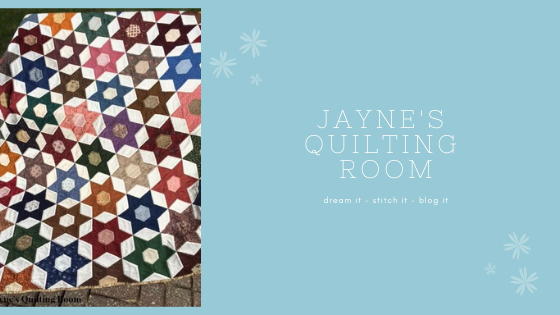This is the quilt I have currently under construction. I am calling it 9-Patch Strippy. All the 9-patches are done by hand. I added the setting triangles by machine. I am now in the process of joining the pieced columns to the plain, also by machine. It is incredibly fast and straightforward. The only thing I am really minding is that I get all the blocks lined up horizontally, which takes some pinning and easing in places.
This 9-patch quilt is made with alternating hourglass blocks. It was fun to do, and went together quite fast. I made top by machine and then I hand-quilted it.
The two quilts above are the same pattern, 9-Patch Criss Cross by Thimbleberries from the book At Home With Thimbleberries Quilts by Lynette Jensen. It uses an economy block to alternate with the 9-patches. I made the blue one first for my DS and it has been used and laundered many, many times. The one pictured above it is still a flimsy. Notice how the look changes with variations in fabrics and placement. I used 3 fabrics in the blue quilt and 4 fabrics - burgundy, gold, navy and cream - in the newer quilt.
The quilt above is another strippy quilt, but it is made differently from the one at the top of this post. Each 9-patch has been turned into an economy block, and then those blocks are set into columns and lined up with straight seams. The same look is achieved; it's just a different way of getting there. This pattern comes from Pick Four by my blogging friend Sue Abrey. She calls it Antique 9-Patches.
Here is another quilt with hand-pieced 9-patches. I had lots of Kaffe Fassett fabric scraps and joined them with white-on-white to make these blocks. Then I just used another KF fabric in deep blue floral for solid setting squares. Because it was a rather small quilt, I added 3 borders. This is a creation of my very own.
Here are 2 quilts made alike with pastel solids and creamy white. The setting block is the same creamy white fabric and the result is a series of diagonal chains across the quilt. I purposely set the colors in rows to accentuate the chains. These are both UFOs, as I made them last June at Quilt Camp and have yet to put the borders on.
And finally, I will show you how different the 9-patch looks when the "chain" is made from the light fabric instead of the dark. This is a 2-fabric quilt - blue floral and white paisley. Love it!
So there you have a quick little lesson in the versatility of the 9-patch. I hand piece some of them; I machine piece some of them. However you like, you will find that this basic block can afford many different looks.
Happy Quilting, Friends!











I love making 9 patches, too. Your quilts are just beautiful. I especially like the first one.. your newest. Gorgeous!
ReplyDeleteWhat an interesting post! I enjoyed reading it. I never thought of sewing 9 patches by hand. That's a good idea. I liked seeing the two versions of Criss Cross and how the blue squares of the second one creates beautiful blue diagonals. Thank you for writing this post.
ReplyDeleteThis comment has been removed by a blog administrator.
ReplyDelete